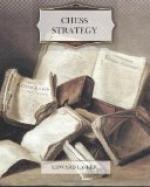With regard to the second irregular reply to 1. P-Q4, namely, 1. ... P-QB4, two ways are open to White. One is to turn the opening into an ordinary Queen’s gambit by playing P-K3, on which Black can play P-Q4. The second is to play 2. P-Q5. Black will then develop his King’s side with P-KKt3 and B-Kt2. The Bishop is well posted here, and can frequently take up an attacking position at K4 or Q5. (See Game No. 45, Rubinstein v. Spielmann.)
If White plays 2. PxP, we have after 2. ... P-K3 a Queen’s gambit accepted by White, and, as pointed out before, this line of play is not commendable.
The last of the three irregular answers mentioned above: 1. ... P-KB4 leads to two entirely different plans, according to the second move chosen by White.
White can confine himself to a simple development such as: Kt-KB3, B-Kt5, P-K3, QKt-Q2 (Kt-B3 would only be good if preceded by P-B4, because Black would again lead into a Queen’s gambit with P-Q4 and P-QB4). The other possibility is the following: in view of the fact that 1. ... P-KB4 does absolutely nothing to aid development, White can initiate a violent attack by giving up his King’s Pawn (P-K4) and thus accelerate his own development. The play might be as follows: 2. ... PxP; 3. Kt-QB3, Kt-KB3; 4. B-KKt5, P-B3 (P-Q4? 5. BxKt followed by Q-R5ch); 5. P-B3. If Black takes the pawn he lays himself open to an attack hard to meet. It seems best to play 5. ... P-K6, which calls back the White QB and leaves White’s BP as a hindrance to the development of the KKt.
IRREGULAR OPENINGS
Many openings in which neither P-K4 nor P-Q4 is the first move lead to well-known positions by a simple transposition of moves. For instance, a Queen’s gambit may well have the following opening moves: 1. P-QB4, Kt-KB3; 2. Kt-KB3, P-K3; 3. Kt-B3, P-B4; 4. P-K3, P-Q4; 5. P-Q4, or a French defence these: 1. Kt-QB3, P-Q4; 2. P-Q4, Kt-KB3; 3. B-Kt5, P-K3; 4. P-K4.
There are, of course, systems of opening which deviate absolutely from those which have been proved sound and are in general use, and it is those openings that puzzle the beginner most of all. He says: What is the good of learning correct openings, if my opponent plays incorrectly and wins all the same? This line of thought is wrong from its inception. The student is not supposed to “learn” openings by heart, but to understand how the general principles of Chess Strategy are applied to any opening. Such knowledge can never be obtained from a tabulated analysis, but can only be arrived at by the application of common sense. If a player succeeds in winning in spite of an inferior opening, it only proves that subsequently he has played a stronger game than his opponent, who, after playing the opening according to the book, did not know how to proceed further. And herein lies the weakness, and not in the absence




